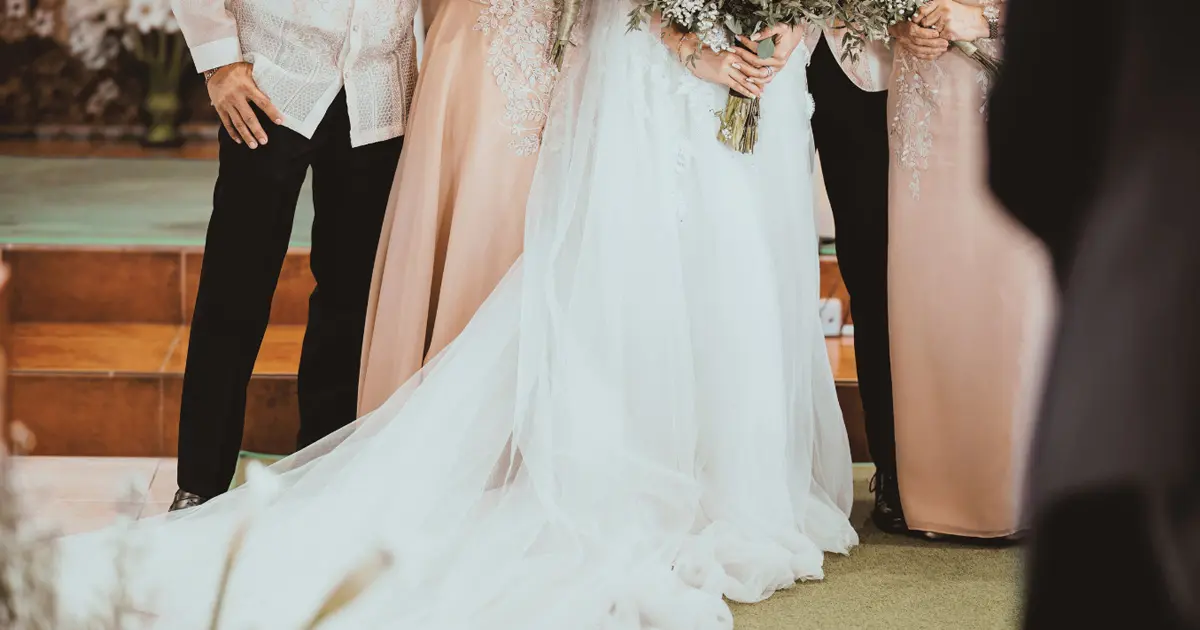As you go around the streets of the Philippines and pass by its many churches, do the sights inspire your curiosity about what a Filipino wedding looks like?
Or maybe you’re already planning a Filipino-themed wedding that will honor your Filipino lover’s roots?
Either way, it would be a great idea to take a closer look at the Philippines’ traditional marriage customs and wedding practices. If only so that you can better prepare and save yourself from any more culture shock.
As you may already know, Filipinos are known to be family-oriented and are mostly Roman Catholics. Therefore, Filipino weddings aren’t just ceremonies of love and union. They are celebrations rich with both of the newlyweds’ families congregating with various customs on display.
Yes, you read that right. There is no single model of what a Filipino wedding looks like.
With the Philippines consisting of at least 7,000 islands with different ethnicities and cultures, every Filipino wedding is a dive into their unique backgrounds.
Traditional vs Modern Filipino Wedding
With the changing times, weddings in the Philippines have also evolved. To ease you into its many intricacies, steer through the following details to keep you informed:
The Traditional Filipino Wedding
Due to the heavy influence of Spanish colonialism, the majority of Filipino wedding traditions are also rooted in Catholic traditions. This is why a church is frequently the top choice for a wedding venue. The joining of the families of the bride and groom is very much highlighted in this ceremony, and the reception is where the festivities begin.
Filipino wedding decorations often include multicolored banderitas or banners and chic tropical details like palm leaves, banana leaves, or abaca, and colorful tropical flowers. Gold tones and wooden elements are also present to make the celebration feel regal.
Aside from having rice as a requirement for just about any occasion, lechon (a slow-roasted stuffed pig), pancit (a noodle with meat, seafood, and vegetables), adobo (boiled and simmered chicken or pork meat mixed with vinegar, soy sauce, garlic, bay leaves, and black pepper), and kakanin (colorful rice cakes made of rice, coconuts, and cane sugar) are the most common Filipino wedding dishes prepared.
For the clothing, the traditional Filipino wedding attire includes the well-known Barong Tagalog for the men and the Terno or Filipiniana for the women.
The Barong in Filipino weddings is traditionally worn for special occasions and the thin, woven pineapple fabric that is almost translucent keeps men cool from the warm climate. It originated from the Tagalog word barò which stands for shirt or clothing. It is a long-sleeved, loose-fitting, untucked clothing paired with a white t-shirt tucked underneath. Its material is often embroidered on the collars and features distinctive designs on the front.
The Terno or Filipiniana for women is famous for its classic large butterfly sleeves. It is an elegant and conservative two-piece dress as it refers to the Spanish word terno which pertains to a matching set of clothes from the same fabric. This wedding dress is beautified with sophisticated embroidered designs and is also woven from pineapple leaves. Aside from the classic bouquet on the hand, a Filipina bride is often seen with a bamboo hand fan to cool themselves throughout the ceremony.
Moreover, what makes this matrimonial celebration even more special is the Filipino wedding tradition with the cord and veil. Abiding by Catholic customs, Filipino wedding sponsors who could be the couple’s godparents or friends, will put the veil over the bride’s head and the groom’s shoulders as a symbol of their union, and to signify humility that God will be by them as they walk through marriage. Then, these sponsors will tie them with the nuptial cord that is rooted in the Holy Rosary. With its looped infinity symbol, this represents the eternal love and devotion between the pair.
The Modern Filipino Wedding
Today’s traditions have already been Western-influenced but this doesn’t imply that the Filipino traditional customs are completely eradicated from the ceremony.
For instance, the modern Filipino wedding dress still embodies the stunning embroidery work. However, as it now leans towards Western culture, white gowns are worn more than the Filipiniana. Then, instead of the conservative and airy traditional design, more brides decide to have Filipino wedding dresses that hug and highlight their figures well.
In some cases, the bride will have her white gown inspired by the Filipiniana’s butterfly sleeves but reduced in size. Also, suits and tuxedos are now being worn by men instead of the traditional Filipino barong tagalog at weddings.
The modern Filipino-themed wedding seldom has multicolors when it comes to the decorations. Instead, they stick to at least one to two color schemes that represent the personalities of the couple. A full Catholic mass is still held but it’s not always being held in churches now as beaches, gardens, hotels or resorts, and restaurants are among the many choices for Filipinos now to hold their vows.
Filipinos are hospitable in nature which is why traditional Filipino weddings are festive as it openly welcomes guests from family to friends to the farthest neighbor one has in their community. It can even reach more than 200 guests. As for modern times, Filipinos are now leaning more toward intimate weddings where the guests are cherry-picked. From what is culturally expected to have over a hundred people, it lowers down to less than 50 at times. However, this often leads to disapproval from elder relatives as, traditionally, a Filipino wedding invitation isn’t too limited.
Considering that these could be foreign to you, it would be best to hire a Filipino wedding planner who could guide you through this process. This way, it saves you time and stress, and most significantly, you get to have an insider knowledge of the culture, the latest trends, and the ideal styles and venues. They could also be your point of contact if you desire customized Filipino wedding attire for you to wear in honor of your partner’s heritage, and help you pick the best Filipino dishes for the wedding to satisfy the hearts and stomachs of your guests.

The Filipiniana is the traditional Filipino wedding attire worn by women.
Some Filipino Wedding Superstitions to Consider
Before you wed a Filipina, know that many Filipinos still cling to wedding superstitions. Most of these will always be backed up by their personal or acquaintance experiences, but I guess there’s nothing to lose if you comply with them:
Sukob
This is a wedding superstition that believes siblings shouldn’t marry within the same year as it means bad luck. With this, it’s preferable to discuss your wedding dates openly with your families.
No Peeking Before The Wedding
They say that if the bride and groom see each other before the ceremony, it might not push through. This stems from past arranged marriages where the grooms didn’t find their brides attractive so they ended up running away.
No Sharp Objects As Gifts
For Filipinos, sharp objects such as knives aren’t a good idea for wedding gifts as it could mean that the marriage will end up broken. You may want to emphasize this on your wedding invitation so your guests will buy more appropriate presents.
The Groom Must Arrive First
It’s considered to be bad luck if the bride arrives first. Also, this is to avoid the groom backing out if he already sees his bride before the ceremony.
Avoid Traveling Before the Wedding
As claimed by wedding superstitions, couples that are nearly to be wed are prone to accidents. To be safe, take this as a sign to go traveling for your honeymoon!
A Filipino wedding is certainly unique on its own. With a good deal of wife material Filipino women, diving and celebrating their background is a piece of cake. Bear in mind these customs and practices and you’ll be walking down the aisle before you even know it.



















